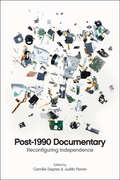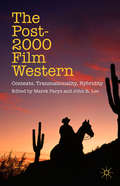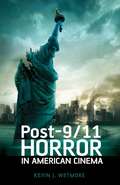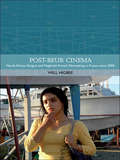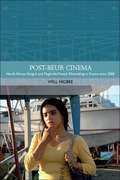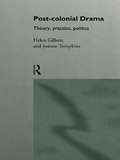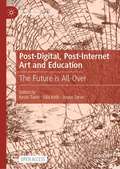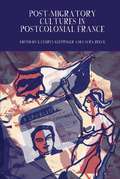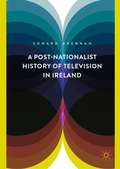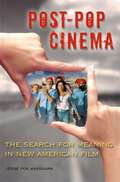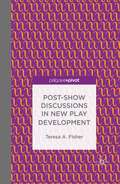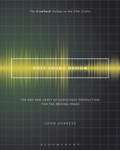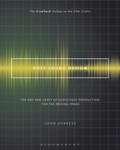- Table View
- List View
Post-1990 Documentary: Reconfiguring Independence
by Camille Deprez Judith PerninThis book questions the meanings of ‘independence’ for documentaries made in the post-1990 context, a period of unrivalled disruption and creativity in the field. Based upon a reasoned selection of contributions, it is the first collection of in-depth case studies cutting across formats, media, subject matters, purposes and national divides. Writing from a wide range of academic perspectives, the contributors shed new light on historical, theoretical and empirical issues pertaining to the independent documentary, in order to better comprehend the radical transformations of the form over the past twenty-five years. Compared to existing studies, this volume focuses on works and practitioners existing at the margins of the traditional media, the mainstream film industry and the prevailing economic and socio-political systems; yet greatly contributing to changing our perception of documentaries. And in doing so, it addresses an important gap in the global understanding of documentary practices and styles.
Post-1990 Documentary: Reconfiguring Independence
by Camille Deprez Judith PerninThis book questions the meanings of ‘independence’ for documentaries made in the post-1990 context, a period of unrivalled disruption and creativity in the field. Based upon a reasoned selection of contributions, it is the first collection of in-depth case studies cutting across formats, media, subject matters, purposes and national divides. Writing from a wide range of academic perspectives, the contributors shed new light on historical, theoretical and empirical issues pertaining to the independent documentary, in order to better comprehend the radical transformations of the form over the past twenty-five years. Compared to existing studies, this volume focuses on works and practitioners existing at the margins of the traditional media, the mainstream film industry and the prevailing economic and socio-political systems; yet greatly contributing to changing our perception of documentaries. And in doing so, it addresses an important gap in the global understanding of documentary practices and styles.
The Post-2000 Film Western: Contexts, Transnationality, Hybridity
by Marek Paryz John R. LeoThis collection explores the post-2000 film Western. With examples ranging from major American films, through acclaimed international productions, to works such as experimental films and television commercials, the contributors seek to account for the appeal and currency of the film Western today.
Post-9/11 Cinema: Through A Lens Darkly (PDF)
by John MarkertCovering cinematic portrayals of 9/11 and the subsequent incursions into Iraq and Afghanistan, Post-9/11 Cinema: Through a Lens Darkly examines both dramas and documentaries that depict what some have termed "Bush's war," as well as rebuttal films, films about terrorist activities, and films seen from the vantage point of journalists and military personnel. This book not only shows how motion pictures reflect societal values but also how such works can influence social attitudes and thus promote change. In addition, Markert appraises the film industry and critiques how images are manipulated to sway the viewer to appreciate the side being advocated.
Post-9/11 Horror in American Cinema
by Kevin J. Wetmore Jr.The horror film is meant to end in hope: Regan McNeil can be exorcized. A hydrophobic Roy Scheider can blow up a shark. Buffy can and will slay vampires. Heroic human qualities like love, bravery, resourcefulness, and intelligence will eventually defeat the monster. But, after the 9/11, American horror became much more bleak, with many films ending with the deaths of the entire main cast. Post-9/11 Horror in American Cinema illustrates how contemporary horror films explore visceral and emotional reactions to the attacks and how they underpin audiences' ongoing fears about their safety. It examines how scary movies have changed as a result of 9/11 and, conversely, how horror films construct and give meaning to the event in a way that other genres do not. Considering films such as Quarantine, Cloverfield, Hostel and the Saw series, Wetmore examines the transformations in horror cinema since 9/11 and considers not merely how the tropes have changed, but how our understanding of horror itself has changed.
Post-9/11 Horror in American Cinema
by Kevin J. Wetmore Jr.The horror film is meant to end in hope: Regan McNeil can be exorcized. A hydrophobic Roy Scheider can blow up a shark. Buffy can and will slay vampires. Heroic human qualities like love, bravery, resourcefulness, and intelligence will eventually defeat the monster. But, after the 9/11, American horror became much more bleak, with many films ending with the deaths of the entire main cast. Post-9/11 Horror in American Cinema illustrates how contemporary horror films explore visceral and emotional reactions to the attacks and how they underpin audiences' ongoing fears about their safety. It examines how scary movies have changed as a result of 9/11 and, conversely, how horror films construct and give meaning to the event in a way that other genres do not. Considering films such as Quarantine, Cloverfield, Hostel and the Saw series, Wetmore examines the transformations in horror cinema since 9/11 and considers not merely how the tropes have changed, but how our understanding of horror itself has changed.
Post-beur Cinema: North African Émigré and Maghrebi-French Filmmaking in France since 2000 (Traditions in World Cinema)
by Will Higbee"Since the early 1980s and the arrival of Beur cinema filmmakers of Maghrebi origin have made a key contribution French cinema's representation of issues such as immigration, integration and national identity. However, they have done so mostly from a position on the margins of the industry. In contrast, since the early 2000s, Maghrebi-French and North African émigré filmmakers have occupied an increasingly prominent position on both sides of the camera, announcing their presence on French screens in a wider range of genres and styles than ever before. This greater visibility and move to the mainstream has not, however, automatically meant that these films have lost any of the social or political relevance. Indeed in the 2000s many of these films have increasingly questioned the boundaries between national, transnational and diasporic cinema, whilst simultaneously demanding, either implicitly or explicitly, a reconsideration of the very difference that has traditionally been seen as a barrier to the successful integration of North African immigrants and their descendants into French society. Through a detailed study of this transformative decade for Maghrebi-French and North African émigré filmmaking in France, this book argues for the emergence of a 'Post-Beur' cinema in the 2000s that is simultaneously global and local in its outlook. "
Post-beur Cinema: North African Émigré and Maghrebi-French Filmmaking in France since 2000 (Traditions in World Cinema)
by Will HigbeeThis book explores the work of these filmmakers on both sides of the camera since the 1970s, offering original perspectives and fresh interpretations of key films, both mainstream and independent.
Post-Cinematic Theatre and Performance (Palgrave Studies in Performance and Technology)
by P. WoycickiA cinema without cameras, without actors, without screen frames and without narratives almost seems like an antithetical impossibility of what is usually expected from a cinematic spectacle. This book defines an emergent field of post-cinematic theatre and performance, challenging our assumptions and expectations about theatre and film.
Post-Colonial Drama: Theory, Practice, Politics
by Helen Gilbert Joanne TompkinsPost-Colonial Drama is the first full-length study to address the ways in which performance has been instrumental in resisting the continuing effects of imperialism. It brings to bear the latest theoretical approaches from post-colonial and performance studies to a range of plays from Australia, Africa, Canada, New Zealand, the Caribbean and other former colonial regions. Some of the major topics discussed in Post-Colonial Drama include: * the interactions of post-colonial and performance theories * the post-colonial re-stagings of language and history * the specific enactments of ritual and carnival * the theatrical citations of the post-colonial body Post-Colonial Drama combines a rich intersection of theoretical approaches with close attention to a wide range of performance texts.
Post-Colonial Drama: Theory, Practice, Politics
by Helen Gilbert Joanne TompkinsPost-Colonial Drama is the first full-length study to address the ways in which performance has been instrumental in resisting the continuing effects of imperialism. It brings to bear the latest theoretical approaches from post-colonial and performance studies to a range of plays from Australia, Africa, Canada, New Zealand, the Caribbean and other former colonial regions. Some of the major topics discussed in Post-Colonial Drama include: * the interactions of post-colonial and performance theories * the post-colonial re-stagings of language and history * the specific enactments of ritual and carnival * the theatrical citations of the post-colonial body Post-Colonial Drama combines a rich intersection of theoretical approaches with close attention to a wide range of performance texts.
Post-Conflict Performance, Film and Visual Arts: Cities of Memory (Contemporary Performance InterActions)
by Des O'Rawe Mark PhelanDrawing on a range of cities and conflicts from Europe, Africa and the Middle East, the collection explores the post-conflict condition as it is lived and expressed in modern cities such as Berlin, Belfast, Bilbao, Beirut, Derry, Skopje, Sarajevo, Tunis, Johannesburg and Harare. Post-Conflict Performance, Film and Visual Arts: Cities of Memory investigates how the memory of conflict can be inscribed in historical monuments, human bodies and hermeneutic acts of mapping, traversing, representing, and performing the city. Several essays explore the relations between memory, history and urban space; where memory is located and how it is narrated, as well as various aspects of embodied memory; testimonial memory; traumatic memory; counter-memory; false memory; post-memory. Other essays examine the representations of post-war cities and how cultural imaginations relate to the politics of reconstruction in places devastated by protracted urban warfare. Post-Conflict Performance, Film and Visual Arts: Cities of Memory offers a comparative survey of the complex and often controversial encounters between public art, political memory and commemoration in divided societies, as well as offering insights into the political and ethical difficulties of balancing the dynamics of forgetting and remembering.
Post-Crisis European Cinema: White Men in Off-Modern Landscapes
by György KalmárThis book explores the cinematic representations of the pervasive socio-cultural change that the 21st century brought to Europe and the world. Discussing films such as I, Daniel Blake, Cold War and Jupiter’s Moon, it puts distinctively “post-crisis”, gendered representations in a complex, theoretically informed and socially committed interdisciplinary perspective that maps the newly emerging formations of masculinity at a time of rapid socio-economic transition. Kalmar argues that the series of crises that started with the 9/11 terrorist attacks changed some of our fundamental expectations about history, debunked many of our grand narratives, and thus changed the cultural logic of our (thoroughly globalized) civilization. The book focuses on the ways cinema reflects, interprets and shapes a rapidly changing world: the hot issues of the times, the new formations of identity, and the shifts in cinematic representation. This is an interdisciplinary research that is equally interested in what new the 21st century brought about, most specifically to Europe and to its white men, as in film and its responses to these socio-cultural changes.
The Post-Dictatorship Generation in Argentina, Chile, and Uruguay: Collective Memory and Cultural Production
by A. RosThe Post-Dictatorship Generation in Argentina, Chile, and Uruguay explores how young adults in Argentina, Chile, and Uruguay make sense of the 1970s socialist projects and the ensuing years of repression in their activism, film, and literature.
Post-Digital, Post-Internet Art and Education: The Future is All-Over (Palgrave Studies in Educational Futures)
by Kevin Tavin Gila Kolb Juuso TervoThis open access edited volume provides theoretical, practical, and historical perspectives on art and education in a post-digital, post-internet era. Recently, these terms have been attached to artworks, artists, exhibitions, and educational practices that deal with the relationships between online and offline, digital and physical, and material and immaterial. By taking the current socio-technological conditions of the post-digital and the post-internet seriously, contributors challenge fixed narratives and field-specific ownership of these terms, as well as explore their potential and possible shortcomings when discussing art and education. Chapters also recognize historical forebears of digital art and education while critically assessing art, media, and other realms of engagement. This book encourages readers to explore what kind of educational futures might a post-digital, post-internet era engender.
Post-Migratory Cultures in Postcolonial France (Francophone Postcolonial Studies #9)
by Kathryn Kleppinger Laura ReeckPost-Migratory Cultures in Postcolonial France offers a critical assessment of the ways in which French writers, filmmakers, musicians and other artists descended from immigrants from former colonial territories bring their specificity to bear on the bounds and applicability of French republicanism, “Frenchness” and national identity, and contemporary cultural production in France. In mobilizing a range of approaches and methodologies pertinent to their specialist fields of inquiry, contributors to this volume share in the common objective of elucidating the cultural productions of what we are calling post-migratory (second- and third-generation) postcolonial minorities.The volume provides a lens through which to query the dimensions of postcoloniality and transnationalism in relation to post-migratory postcolonial minorities in France and identifies points of convergence and conversation among them in the range of their cultural production. The cultural practitioners considered query traditional French high culture and its pathways and institutions; some emerge as autodidacts, introducing new forms of authorship and activism; they inflect French cultural production with different ‘accents’, some experimental and even avant-garde in nature. As the volume contributors show, though post-migratory postcolonial minorities sometimes express dis-settlement, they also provide an incisive view of social identities in France today and their own compelling visions for the future.
A Post-Nationalist History of Television in Ireland
by Edward BrennanThis book explores the question of how society has changed with the introduction of private screens. Taking the history of television in Ireland as a case study due to its position at the intersection of British and American media influences, this work argues that, internationally, the transnational nature of television has been obscured by a reliance on institutional historical sources. This has, in turn, muted the diversity of audience experiences in terms of class, gender and geography. By shifting the focus away from the default national lens and instead turning to audience memories as a key source, A Post-Nationalist History of Television in Ireland defies the notion of a homogenous national television experience and embraces the diverse and transnational nature of watching television. Turning to people’s memories of past media, this study ultimately suggests that the arrival of the television in Ireland, and elsewhere, was part of a long-term, incremental change where the domestic and the intimate became increasingly fused with the global.
Post-Pop Cinema: The Search for Meaning in New American Film
by Jesse Fox MaysharkStarting in the early 1990s, artists such as Quentin Tarantino, David Foster Wallace, and Kurt Cobain contributed to a swelling cultural tide of pop postmodernism that swept through music, film, literature, and fashion. In cinema in particular, some of the arts most fundamental aspects—stories, characters, and genres, for instance—assumed such a trite and trivialized appearance that only rarely could they take their places on the screen without provoking an inward smirk or a wink from the audience. Out of this highly self-conscious and world-weary environment, however, a new group of filmmakers began to develop as the decade wore on, with a new set of styles and sensibilities to match. In Post-Pop Cinema author Jesse Fox Mayshark takes us on a film-by-film tour of the works of these filmmakers-including Wes and P. T. Anderson, Sofia Coppola, Richard Linklater, Alexander Payne, and David O. Russell-and seeks to reveal how a common pool of styles, collaborators, and personal connections helps them to confront the unifying problem of meaning in American film.Wes Anderson's Bottle Rocket (1996) and Paul Thomas Anderson's Boogie Nights (1997) were ultimately about their characters' lives-even though their characters often dealt with highly contrived environments and situations. And soon after Wes Anderson scored his first success, others like David O. Russell (Flirting With Disaster, Three Kings), the screenwriter Charlie Kaufman (who collaborated with Spike Jonze on such projects as Being John Malkovich and Adaptation), Alexander Payne (Election, Sideways), Richard Kelly (Donnie Darko), and Sofia Coppola (Lost in Translation) began to tread their own paths over this same ground. Although these men and women represent a wide range of styles and subject matter, all their films revolve in different ways around the difficulty of establishing and maintaining connections. This theme of connection also runs deeper than the films made: the directors share actors (Mark Wahlberg, Bill Murray, Ben Stiller, Jason Schwartzman), collaborators (the musician Jon Brion) and sometimes even personal connections (Spike Jonze starred in Russell's Three Kings, and was married to Coppola). Together these filmmakers form a loose and distinctly American school of filmmaking, one informed by postmodernism but not in thrall to it, and one that every year becomes more important to the world of cinema both within and beyond the United States.
Post-Production and the Invisible Revolution of Filmmaking: From the Silent Era to Synchronized Sound (Routledge Advances in Film Studies)
by George LarkinPost-Production and the Invisible Revolution of Filmmaking studies the discourses surrounding post-production, as well as the aesthetic effects of its introduction during the 1920s and 1930s, by exploring the philosophies and issues faced by practitioners during this transitional, transformative period. The introduction of post-production during the transition from silent cinema to the synchronized sound era in the 1920s American studio system resulted in what has been a previously unheralded and invisible revolution in filmmaking. Thereafter, a film no longer arose from a live and variable combination of audio and visual in the theater, as occurred during the silent film era, where each exhibition was a singular event. The new system of post-production effectively shifted control of a film’s final form from the theater to the editing room. With this new process, filmmakers could obtain and manipulate an array of audio elements and manufacture a permanent soundtrack. This transition made possible a product that could be easily mass-produced, serving both to transform and homogenize film presentation, fundamentally creating a new art form. With detailed research and analysis and nearly 50 illustrations, this book is the ideal resource for students and researchers of film history and post-production.
Post-Production and the Invisible Revolution of Filmmaking: From the Silent Era to Synchronized Sound (Routledge Advances in Film Studies)
by George LarkinPost-Production and the Invisible Revolution of Filmmaking studies the discourses surrounding post-production, as well as the aesthetic effects of its introduction during the 1920s and 1930s, by exploring the philosophies and issues faced by practitioners during this transitional, transformative period. The introduction of post-production during the transition from silent cinema to the synchronized sound era in the 1920s American studio system resulted in what has been a previously unheralded and invisible revolution in filmmaking. Thereafter, a film no longer arose from a live and variable combination of audio and visual in the theater, as occurred during the silent film era, where each exhibition was a singular event. The new system of post-production effectively shifted control of a film’s final form from the theater to the editing room. With this new process, filmmakers could obtain and manipulate an array of audio elements and manufacture a permanent soundtrack. This transition made possible a product that could be easily mass-produced, serving both to transform and homogenize film presentation, fundamentally creating a new art form. With detailed research and analysis and nearly 50 illustrations, this book is the ideal resource for students and researchers of film history and post-production.
Post-Show Discussions in New Play Development (Palgrave Pivot Ser.)
by T. FisherMany theatres host post-show discussions, or talkbacks, as part of their season. This book is a critical examination of what has/has not worked with post-show discussions utilized in new play development, providing a framework for understanding discussions, steps for building the foundation of them, and various strategies for structuring them.
Post Sound Design: The Art and Craft of Audio Post Production for the Moving Image (The CineTech Guides to the Film Crafts)
by John AvaresePost Sound Design provides a practical introduction to the fascinating craft of editing and replacing dialog, creating Foley and sound effects, editing music, and balancing these elements to a final mix. Based on years of experience and teaching this material to students at Drexel University, award-winning film composer John Avarese offers user-friendly knowledge and stimulating exercises to help compose story, develop characters and create emotion through skillful creation of the sound track. Starting each chapter with a real-life example, the textbook is structured in such a way to create a fundamental understanding of the physics and the biological foundation of hearing, and putting it into practice with suggested movie scenes demonstrating the discussed audio techniques. Post Sound Design engagingly demonstrates the individual areas essential to creating a soundtrack that will enhance any media production.
Post Sound Design: The Art and Craft of Audio Post Production for the Moving Image (The CineTech Guides to the Film Crafts)
by John AvaresePost Sound Design provides a practical introduction to the fascinating craft of editing and replacing dialog, creating Foley and sound effects, editing music, and balancing these elements to a final mix. Based on years of experience and teaching this material to students at Drexel University, award-winning film composer John Avarese offers user-friendly knowledge and stimulating exercises to help compose story, develop characters and create emotion through skillful creation of the sound track. Starting each chapter with a real-life example, the textbook is structured in such a way to create a fundamental understanding of the physics and the biological foundation of hearing, and putting it into practice with suggested movie scenes demonstrating the discussed audio techniques. Post Sound Design engagingly demonstrates the individual areas essential to creating a soundtrack that will enhance any media production.
Post-Unification Turkish German Cinema: Work, Globalisation and Politics Beyond Representation
by Gozde NaibogluThis book offers a post-representational approach to a range of fiction and non-fiction films that deal with labour migration from Turkey to Germany. Engaging with materialist philosophies of process, it offers analyses of films by Thomas Arslan, Christian Petzold, Aysun Bademsoy, Seyhan Derin, Harun Farocki, Yüksel Yavuz and Feo Aladag. Shifting the focus from the longstanding concerns of integration, identity and cultural conflict, Gozde Naiboglu shows that these films offer new expressions of lived experience under late capitalism through themes of work, social reproduction, unemployment and insecure work, exhaustion and precarity, thereby calling for a rethinking of the established ideas of class, community and identity.
Post-Unification Turkish German Cinema: Work, Globalisation and Politics Beyond Representation
by Gozde NaibogluThis book offers a post-representational approach to a range of fiction and non-fiction films that deal with labour migration from Turkey to Germany. Engaging with materialist philosophies of process, it offers analyses of films by Thomas Arslan, Christian Petzold, Aysun Bademsoy, Seyhan Derin, Harun Farocki, Yüksel Yavuz and Feo Aladag. Shifting the focus from the longstanding concerns of integration, identity and cultural conflict, Gozde Naiboglu shows that these films offer new expressions of lived experience under late capitalism through themes of work, social reproduction, unemployment and insecure work, exhaustion and precarity, thereby calling for a rethinking of the established ideas of class, community and identity.
